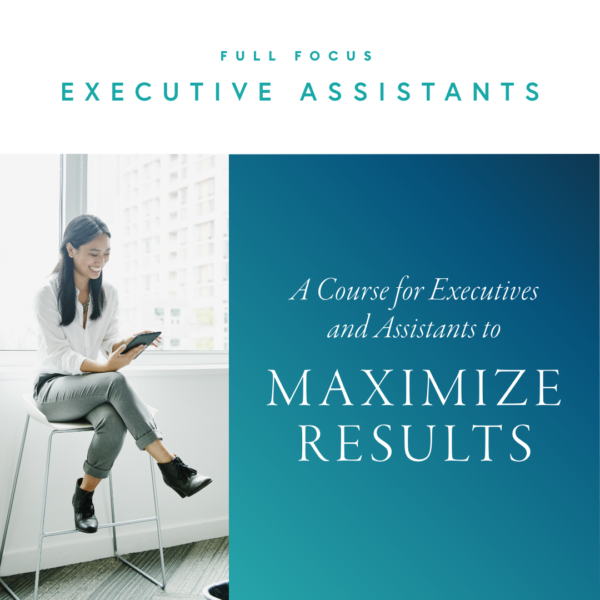I was recently speaking to a group of business owners. “Hey,” I said, “I’m just curious. By a show of hands, how many of you have an executive assistant?” Only half raised their hand.
When I asked those without why they hadn’t hired an EA, I got several reasons. I heard myself in a few of them.
Back when I was in the corporate world, serving as the CEO of Thomas Nelson Publishers, I had two full-time executive assistants. One managed my calendar and booked my travel. The other managed my inbox, took meeting notes, and performed other tasks I needed to execute my role.
If I’m honest, it felt like a lot. Overkill. So when I stepped away to start the company that’s now Full Focus, I thought I’d go it alone.
A Costly Realization
I developed an attitude that executive assistants were for people who couldn’t manage on their own. I decided I would do it all by myself. I was finished with the bureaucracy of a big company and didn’t want to replicate it in my new business.
Well, that attitude lasted about three months. I found myself totally engulfed in all sorts of administrative tasks for which I had zero passion and even less proficiency.
I’d always prided myself on inbox zero, but I was falling behind. I was booking travel and making a total mess of it. Worse, I was spending time on activities that didn’t directly generate revenue or enable my business to grow.
I had an EA—it was me! Not only was I poor at the work, it was costing me tons.
After realizing I was limiting my own growth, I ended up contacting Belay and hiring a virtual EA for ten hours a week. It made an enormous difference almost immediately. And here’s the thing: I find this is true for any executive or entrepreneur who hires an EA for themselves, even if they don’t fully maximize the role.
That’s what I told those 50 percent of business owners I was speaking with. In fact, in my case I found the ROI so great, it wasn’t long before I’d scaled up to a full-time EA—and I choose that verb intentionally.
You cannot scale your business unless you can scale yourself. That’s the foundation for everything else. You’ll quickly run out of hours, energy, focus, attention, and creativity unless you figure out how to scale yourself.
An executive assistant is the first step toward that. In fact, there’s probably no hire more essential for a successful business owner or executive than a great executive assistant.
Let’s explore how by looking at three essential tasks a world-class EA can do for you.
Task 1: Clearing Time for High-Leverage Work
Time is a zero-sum game; a yes to my inbox is a no to a higher-leverage project. Practically speaking, when I was busy managing my calendar and my inbox, I wasn’t busy achieving my business goals.
Yes, it’s possible to view administrative work as a means to an end—serving my goals. But I had zero passion and no proficiency. So I was diverting scarce resources from work that could more directly contribute to my goals. In that sense, my time cost far more than an EA’s salary, and using it on administrative work reduced the bandwidth I could spend doing what only I could do to move my business forward.
I tell business owners to think of an executive assistant as their partner in goal pursuit. You can inform them you want to primarily focus on, say, three particular goals for the coming quarter. They can then guard your calendar and clear time to ensure you have enough space to work on those goals.
I asked my executive assistant, Jim Kelly, about this. “I free you up to do only what you can do,” he said. “For the business, that means creating content, presenting content, and then leading alongside Megan [Hyatt Miller, Full Focus’s CEO].” If it’s outside those primary areas, Jim actively protects my bandwidth by passing on opportunities and keeping my schedule free.
He’s developed what he calls No Templates. “If a request comes in and someone says, ‘Hey, can we have Michael at this event?’ or, ‘Can I take Michael to lunch to pick his brain?’ I have four or five different templates. . . . I say it all in respectful ways, but I hold your boundaries very tightly.”
Jim also ensures my schedule aligns with my Ideal WeekTM. That allows me to be hyper productive and manage my energy on a daily and weekly basis.
It’s easy to discount this kind of work. The busier we are, the easier it is to jump into Monday and just hope for the best. But more often than not, Friday rolls around faster than we realize, and we haven’t made enough progress on our goals for a very simple reason: we didn’t preserve time for it. An EA can ensure that time gets set aside on the front end.
Task 2: Handling Coordination and Communication
One challenge of leadership is being in too many places, and fielding too many messages, at once. Coordination and communication are real and distinct challenges.
When I tried this for myself, yes, I could do it. But the result wasn’t stellar. And I always had dropped balls or missed steps that I had to circle back to address.
Managing coordination and communication at the executive level is like being a pilot with too many planes in the airspace around you. But a great EA is like an air-traffic controller for your life, handling the logistical decisions and communication that eats up bandwidth and brain cycles.
And they do it really well. Instead of coming behind, cleaning up messes, they’re going in front of you, making the way clear so that you can stay focused on your highest-leverage work.
In the case of my EA, Jim looks ahead seven to ten days in advance. “I’m just making sure that you have everything you need for your appointments, whether that be driving time, agendas for meetings, everything that you need,” he said. “I want you to just look at your calendar, know exactly where you need to be at what time, and then everything else, all the details, are in the rest of the calendar. And you don’t have to worry about anything.”
According to research by software giant Adobe, the average white-collar worker spends just over three hours a day managing their work email and another two and a half hours tending their personal inbox.
Depending on what’s happening in your business, you might spend 30 to 40 percent of your time here. Or, with an EA, you could invest that time driving results in your business by making progress toward your goals doing the kind of high-leverage work only you can do.
Thanks to my executive assistant, my inbox is managed. I don’t double-book appointments. And most of the conflicts I might have to manage I never know about, because Jim has anticipated and resolved them before it becomes an issue.
Task 3: Managing Meetings and Necessary Follow-Up
All the entrepreneurs and executives I know spend a lot of time in meetings. Whether on Zoom or in person, gathering with key team members and external partners are how work gets done. It’s essential time.
One extensive study of CEO schedules, published in Harvard Business Review, revealed they spent three quarters of their week in meetings—as many as 37 individual meetings of varying duration.
I used to be critical of meetings, if I’m honest. What I eventually realized, however, is that I don’t dislike meetings. I dislike ineffective meetings. Good meetings produce great work. Bad meetings waste everyone’s time and compromise our team’s ability to achieve goals. I wrote No-Fail Meetings precisely to help our clients prevent that from happening.
One surefire way to improve the quality of meetings you attend is to change your responsibilities in them—and that’s where an EA can prove essential.
We’ve already addressed scheduling. Unless your executive assistant is unavailable, you should really never schedule your own meetings; that’s a coordination function that can pull you away from higher-leverage tasks. Beyond that, let’s address three other responsibilities:
- Note taking. When you’re in meetings, take what minimal notes you need to stay engaged and capture key thoughts. Never keep minutes or detailed notes. If those are necessary, save that work for your EA. Taking detailed notes means you’ll end up losing key parts of the conversation. If you’re in a meeting, your job is the conversation—not notes.
- Facilitation. Just because you called and are leading the meeting doesn’t mean you have to facilitate it. If you’re policing the agenda, trying to track the time, and all the rest, you’ll fracture your attention and focus on parts of the meeting that someone else can handle more efficiently than you. Same as note taking: if you’re in a meeting, your job is the conversation—not watching the clock.
- Follow-up. Meetings are pointless if nothing happens afterward. That necessitates assignments and follow-up. Since my executive assistant has been keeping notes, they also keep track of action items and commitments as we cover those at the end of the meeting. Beyond that, they can check in with the parties at a later date to ensure that action is taken.
When a leader drops the ball or doesn’t follow through on a commitment it can really compromise our integrity and our team’s confidence in us. Just as bad, inaction doesn’t move the business forward.
I always have Jim track my action items in meetings. It not only makes me look great because I’m always following through, but it also sets the pace for the entire organization: we make commitments, we keep commitments.
Meetings are usually unavoidable and can be hugely helpful if they’re effective. Time and again I’ve found that just introducing an EA into the mix can automatically up your meetings game.
An executive assistant isn’t just someone who does the stuff we don’t want to do. Hiring a great executive assistant is like manufacturing time. In all three of these tasks—clearing time for high-leverage work, handling coordination and communication, and managing meetings—the right EA can be the difference maker on your team. They’re a collaborative partner in achieving results.
What I’ve shared above is the tip of the iceberg. One thing we pride ourselves on at Full Focus is training executive assistants and helping our clients maximize that role in their business.
To that end, we’ve just released a new course for both leaders and EAs. It’s called Full Focus Executive Assistants. You can find out more by clicking below.
Last modified on October 10th, 2022 at 9:24 am
Disclosure of Material Connection: Some of the links in the post above are “affiliate links.” This means if you click on the link and purchase the item, we will receive an affiliate commission. Regardless, we only recommend products or services we use and believe will add value to our readers. We are disclosing this in accordance with the Federal Trade Commission’s 16 CFR, Part 255: “Guides Concerning the Use of Endorsements and Testimonials in Advertising.










